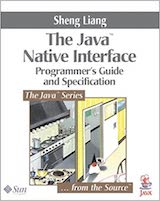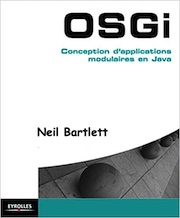
|
FreeComputerBooks.com
Links to Free Computer, Mathematics, Technical Books all over the World
|
|
- Title The Java Native Interface: Programmer's Guide and Specification
- Author(s) Sheng Liang
- Publisher: Addison-Wesley Professional
- Paperback 303 pages
- eBook: PDF (318 pages)
- Language: English
- ISBN-10: 0201325772
- ISBN-13: 978-0201325775
- Share This:

|
The complete tutorial, programming guide, and reference for Java Native Interface (JNI), the interface which facilitates the integration of Java with existing C and C++ code. This book answers that need by presenting no-nonsense, nuts-and-bolts coverage of the new "niche" APIs like JNI, JTAPI, and the Java Wallet in a task-oriented reference format that gives coders the answers they need.
About the Authors- Sheng Liang, a staff engineer in Java Software at Sun Microsystems, Inc., designed the JNI and led the Java virtual machine development for the first release of the Java 2 platform. He holds a Ph.D. in computer science from Yale University.
- Advanced Java Programming
- C Programming
- C++ Programming
- Java Distributed Computing and Networking
- Java GUI Design and Programming

- The Java Native Interface: Programmer's Guide and Specification (Sheng Liang)
- The Mirror Site (1) - PDF
- The Mirror Site (2) - PDF
-
 Dynamic Proxies in Java (Heinz M. Kabutz)
Dynamic Proxies in Java (Heinz M. Kabutz)
Dynamic proxies are such a tool that we can use it to save thousands of lines of repetitive code with a single class. This book is for intermediate to advanced Java programmers who want to get to "guru" status. It is not suitable for beginners in Java.
-
 The Java Web Scraping Handbook (Kevin Sahin)
The Java Web Scraping Handbook (Kevin Sahin)
This book will teach you how to extract data from any website, how to deal with AJAX / Javascript heavy websites, break captchas, deploy your scrapers in the cloud and many other advanced techniques, using Java programming language.
-
 Naked Objects (Richard Pawson, et al)
Naked Objects (Richard Pawson, et al)
The aim of this book is to introduce you to the concept of designing business systems from naked objects, and to enable you to start building such systems using the Naked Objects framework. It outlines a lightweight methodology and provides a short tutorial.
-
 Java Transaction Design Strategies (Mark Richards)
Java Transaction Design Strategies (Mark Richards)
This book is about how to design an effective transaction management strategy using the transaction models provided by Java-based frameworks such as EJB and Spring. Techniques, best practices, and pitfalls with each transaction model will be described.
-
 Playing with Java Microservices on Kubernetes and OpenShift
Playing with Java Microservices on Kubernetes and OpenShift
This book is written for Java developers who wants to build microservices using the Spring Boot/Cloud stack and who wants to deploy them to Kubernetes and OpenShift. Heach you how to build and design microservices using Java and the Spring platform.
-
 Object-Oriented vs. Functional Programming (R. Warburton)
Object-Oriented vs. Functional Programming (R. Warburton)
This book discusses similarities between these programming paradigms and points out that both FP and OOP are actually moving closer toward one another. One prominent example is the use of lambda expressions in Java and other OOP languages.
-
 High-Performance Java Platform Computing
High-Performance Java Platform Computing
Threading and concurrency are crucial to building high-performance Java applications. This book thoroughly demystifies them, helping developers leverage threading and concurrency to solve a wide variety of performance problems.
-
 Docker for Java Developers (Arun Gupta)
Docker for Java Developers (Arun Gupta)
This book introduces basic Docker concepts and explains how to achieve faster startup and deployment of your Java‑based applications, shows how Docker containers can save you many headaches when it comes to packaging, deploying, and scaling your applications.
-
 OSGi In Practice (Neil Bartlett)
OSGi In Practice (Neil Bartlett)
This book is a comprehensive guide to OSGi with two primary goals: first introducing to OSGi concepts with examples, then exploresing numerous practical scenarios and techniques, as well as answering questions.
-
 Building Reactive Microservices in Java (Clement Escoffier)
Building Reactive Microservices in Java (Clement Escoffier)
This book is for developers and architects interested in developing microservices and distributed applications. It does not explain the basics of distributed systems, but instead focuses on the reactive benefits to build efficient microservice systems.
-
 Microservices for Java Developers: Frameworks and Containers
Microservices for Java Developers: Frameworks and Containers
In this hands-on, example-driven guide, Java developers and architects will learn how to navigate popular application frameworks, such as Dropwizard and Spring Boot, and how to deploy and manage microservices at scale with Linux containers.
-
 Microservices Best Practices for Java (Michael Hofmann, et al)
Microservices Best Practices for Java (Michael Hofmann, et al)
This book covers Microservices best practices for Java. It focuses on creating cloud native applications using the latest version of Server and other Open Source Frameworks in the Microservices ecosystem to highlight Microservices best practices for Java.
-
 Processing XML with Java: A Guide to SAX, DOM, JDOM, JAXP
Processing XML with Java: A Guide to SAX, DOM, JDOM, JAXP
A complete guide to writing Java programs that read and write XML documents. Shows developers how to save XML documents, read XML documents, communicate with network servers that send and receive XML data, and integrate XSLT into their programs.
|
:
|
|
 |
|
 |
|
 |
|
 |
|
 |
|
 |
|
 |
|
 |
|
 |
|
 |
|
 |
|
 |
|
 |
|
 |
|
 |
|
 |
|
 |
|



